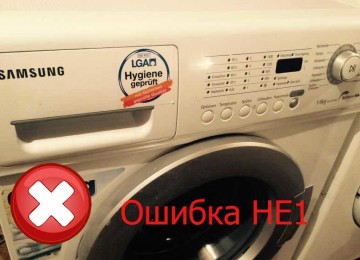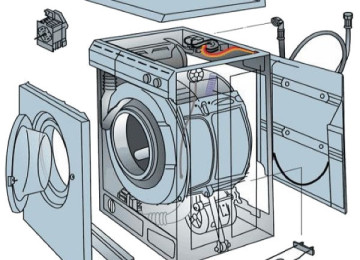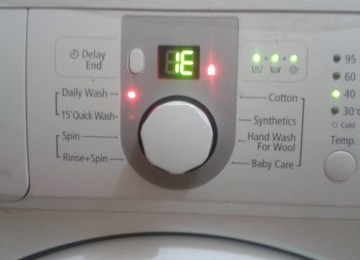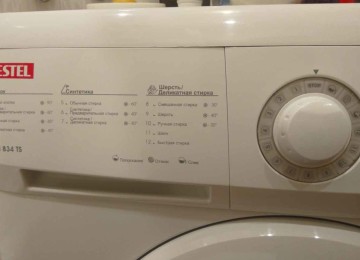When purchasing a washing machine, few people pay attention to the design features. But this will help reduce the cost of possible repairs. Washing machines with a collapsible tank are considered the most repairable option. However, finding and distinguishing such models is quite difficult. There are several ways to identify equipment with a split tank.
What is the difference between a tank and a drum
A drum is a non-separable container that is used to store laundry. The material used is always high quality stainless steel. The inner surface is pierced with holes through which water and detergent are poured. The container rotates constantly, which helps clean the fabric. After all, the laundry constantly rubs against the inner surface.
Unlike the drum, the tank remains stationary throughout the entire cycle. It is usually made of either a polymer composition or stainless steel. The first option is more economical and is most common. During the washing period, the container is filled with water, which gradually enters the drum through the perforations. The tank can be collapsible or solid. Split parts are preferred as they make repairs easier.
Differences between a collapsible tank and a non-collapsible one
The main reason that forces users to choose models with a split part is maintainability. If the bearings fail, replacement costs will be minimal. After all, you only need to separate the two halves of the container in order to dismantle the failed parts. This is quite simple to do, since the parts are fastened with special bolts.
Solid tanks usually cannot be repaired and must be replaced with new ones. Such measures are very expensive, so many users prefer to purchase another model. After all, in essence, not only the tank is replaced, but also the drum, bearings and other parts. Their removal and installation in a similar container is not possible.
In some cases, repairmen may suggest cutting the tank into two halves. However, this is true more for stainless steel parts. Such containers can be hermetically connected thanks to welding. Plastic tanks are rarely sawn, as the fragile material can simply crack in the process. However, even with successful separation of the part, the question of combining the parts arises.
Plastic tanks cannot be welded, and gluing will not provide sufficient tightness. Therefore, a tank repaired in this way can sometimes leak. In addition, due to the complexity of repairs, few craftsmen agree to cut a non-separable tank.
Companies that produce washing machines with collapsible tanks
Just 10 years ago, the majority of the market was occupied by washing machines with collapsible tubs. Now, an increasing number of brands are refusing to use such parts, preferring non-separable containers. Solid cast structures can greatly reduce the cost of production.
However, this solution is not very beneficial for the buyer. After a bearing failure, you will be faced with a choice: pay almost 50% of the cost of the device for repairs or purchase a new product. Fortunately, there are still companies on the market that supply washing machines with a collapsible tank.
Among these brands are:
- Samsung.
 The Korean manufacturer produces innovative devices. Thus, many models are controlled via a smartphone. Moreover, the brand is not limited to producing exclusively premium products. The price for the most budget model starts at 18,000 rubles. Given the range of prices, the company uses both disassembled and solid tanks.
The Korean manufacturer produces innovative devices. Thus, many models are controlled via a smartphone. Moreover, the brand is not limited to producing exclusively premium products. The price for the most budget model starts at 18,000 rubles. Given the range of prices, the company uses both disassembled and solid tanks. - LG.
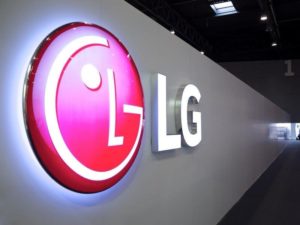 The Korean company produces models for a wide range of consumers. Among the assortment you can find devices with prices ranging from 18,000 to 275,000 rubles. The brand produces products that are reasonably priced and have good functionality. The company equips devices with the latest technology, using the latest technologies.
The Korean company produces models for a wide range of consumers. Among the assortment you can find devices with prices ranging from 18,000 to 275,000 rubles. The brand produces products that are reasonably priced and have good functionality. The company equips devices with the latest technology, using the latest technologies.
Taking into account the requirements of potential buyers, the company supplies washing machines with collapsible containers. However, if the bearings fail, they cannot be replaced. The part will have to be replaced along with the back of the tank. However, this solution is more economical than that offered by companies specializing in non-separable containers. - Siemens.
 The company brings to the market models with both collapsible containers and solid ones. There are products with different types of installation, dimensions can also be selected. The brand offers both narrow and full-size devices. Among the assortment, two models can be distinguished: WM14W740EU, WS12T440BY.
The company brings to the market models with both collapsible containers and solid ones. There are products with different types of installation, dimensions can also be selected. The brand offers both narrow and full-size devices. Among the assortment, two models can be distinguished: WM14W740EU, WS12T440BY. - A.E.G.
 The German company chose the middle and premium segment as its target audience. Therefore, the most budget model costs from 32,000 rubles.The range includes modifications with different loading, installation and dimensions. The type of tank used varies depending on the model in question. Products with detachable containers include: L7FEE48S, L8FEC68SR.
The German company chose the middle and premium segment as its target audience. Therefore, the most budget model costs from 32,000 rubles.The range includes modifications with different loading, installation and dimensions. The type of tank used varies depending on the model in question. Products with detachable containers include: L7FEE48S, L8FEC68SR. - Atlant.
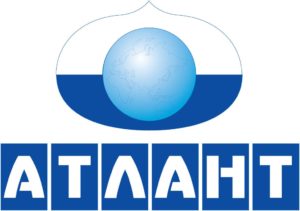 The Belarusian brand puts on the market models aimed at the budget market. It is not surprising that company representatives prefer to spend money on collapsible tanks. After all, this will help attract a potential audience. As an example, we can cite devices numbered 50У101 and 60С101.
The Belarusian brand puts on the market models aimed at the budget market. It is not surprising that company representatives prefer to spend money on collapsible tanks. After all, this will help attract a potential audience. As an example, we can cite devices numbered 50У101 and 60С101. - Electrolux.
 The Swedish manufacturer offers products for a wide range of consumers. The range is wide, with models of different installation, loading and sizes available. There are also devices with collapsible containers, but the brand is gradually introducing solid ones.
The Swedish manufacturer offers products for a wide range of consumers. The range is wide, with models of different installation, loading and sizes available. There are also devices with collapsible containers, but the brand is gradually introducing solid ones. - Gorenje.
 The Slovenian manufacturer focuses on the budget segment; the brand’s washing machines are among the cheapest. The lower price level starts from 14,000 rubles. However, due to the desire to reduce production costs, the company began to introduce non-demountable structures. Fortunately, devices with a detachable design are still produced, such as the W7513/S1.
The Slovenian manufacturer focuses on the budget segment; the brand’s washing machines are among the cheapest. The lower price level starts from 14,000 rubles. However, due to the desire to reduce production costs, the company began to introduce non-demountable structures. Fortunately, devices with a detachable design are still produced, such as the W7513/S1. - Bosch.
 The German manufacturer provides both variations to the market. However, the company does not hide the type of built-in tank from the user. You can find out the type of part used by the marking: WAA - accompanies one-piece structures, WAE - only split ones are indicated.
The German manufacturer provides both variations to the market. However, the company does not hide the type of built-in tank from the user. You can find out the type of part used by the marking: WAA - accompanies one-piece structures, WAE - only split ones are indicated. - Haier.
 The Chinese brand specializes in the production of frontal models. The company does not adhere to a specific price segment, offering both budget and premium products. One of the company’s interesting new products is a device with two drums.
The Chinese brand specializes in the production of frontal models. The company does not adhere to a specific price segment, offering both budget and premium products. One of the company’s interesting new products is a device with two drums.
Companies producing washing machines with non-removable tanks
Brands that have switched to one-piece designs include:
- Ariston;
- Candy;
- Beko;
- Indesit;
- Whirlpool;
- ARDO;
- Zanussi.
The reason for the popularity of non-separable tanks is simple - money. It is not profitable for companies to supply washing machines with detachable parts. Therefore, more and more manufacturers are taking steps towards solid tanks.
Methods for determining the type of tank in washing equipment
Nowadays manufacturers prefer to put on the market models with a non-separable tank. Moreover, high-strength polymers are used as materials. This allows you to save a lot on production, but there are also tangible benefits for buyers. Non-removable plastic tanks reduce energy costs. And given their increased strength, they will last quite a long time.
However, all of the above advantages are negated by just one drawback - expensive repairs. If the bearings wear out, you will need to pay an order of magnitude more for replacement than with a collapsible tank. It's no surprise that many consumers prefer to avoid solid-tank washing machines. Manufacturers know this, so they prefer to hide information about design features.
Unfortunately, most consumers become aware of the nuances of the tank structure after purchase. Typically, the presence of a non-separable container is made known to the repair specialist when the bearing fails. Often, when selecting a suitable model, the consultant will tell you in detail about the functionality, washing and spinning features. However, design features will not be considered. Therefore, you will have to understand this issue yourself.
There are several ways to determine the type of tank:
- Consult the seller.Of course, information about the internal structure of the device is usually hidden from the buyer, but it’s worth a try. Perhaps the consultant will accommodate you and provide information.
However, it is worth considering the possibility of a banal error. In addition, the consultant may simply not be competent in such matters and will not be able to clarify the situation. Therefore, you should not completely trust the information received. - Talk to a washing machine repairman. They are well versed in the features of equipment from various brands. Therefore, they can suggest a suitable company and model. However, this method does not guarantee the purchase of a washing machine with a collapsible tank.
After all, the manufacturer can simply make changes to the product. Thus, the line, which previously included only products with a collapsible tank, can be equipped with solid cast containers. Moreover, both the entire model range and some models may undergo changes. - Remove the top panel. If you convince the consultant of the need to study the internal structure of the equipment, then the type of tank will be visible. Typically, collapsible containers have bolts that hold the two separate halves together. Therefore, it will be easy to distinguish a split tank from a solid one. However, many sellers refuse to remove the top panel.
- Look under the bottom. If the seller refuses to remove the top panel, then ask to tilt the device forward. This will provide a viewing angle sufficient to determine the type of tank. There should be no difficulties, because exhibition samples do not have a bottom.
Conclusion
It is becoming difficult to find a washing machine with a collapsible tank. Most manufacturers have either already switched to one-piece construction or are on their way to doing so.Only a few companies continue to supply models with exclusively detachable tanks. One of these brands is Atlant. The products can be safely purchased, since the manufacturer takes a step towards buyers, providing repairable models. similar entries from this section






